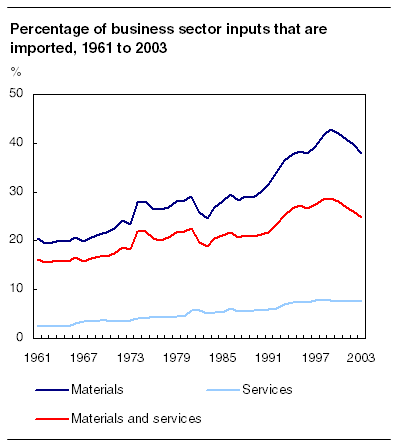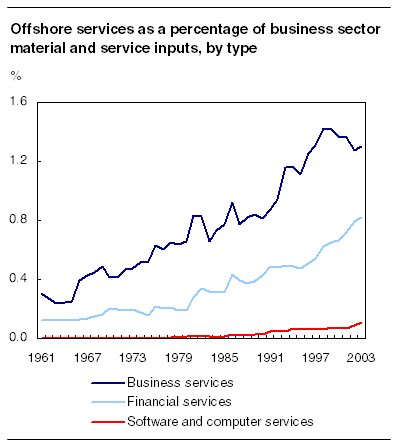Common menu bar links
Study: Outsourcing and offshoring in Canada
Archived Content
Information identified as archived is provided for reference, research or recordkeeping purposes. It is not subject to the Government of Canada Web Standards and has not been altered or updated since it was archived. Please "contact us" to request a format other than those available.

Canadian industries steadily increased their levels of both "outsourcing" and "offshoring" from 1961 to 2003, according to a new research paper that assesses trends in international trading patterns.
Outsourcing involves moving production outside a firm. Offshoring occurs when Canadian-based companies buy foreign-produced goods or services as production inputs.
The study found that between 1961 and 2003, there was a strong shift towards the offshoring of both goods and services, which increased in almost all industries. The rate of growth of offshoring has been highest in service industries.
The study suggests that offshoring in goods has been positively related to multifactor productivity growth. Service offshoring has been associated with a shift towards higher value-added activities in Canadian industries.
The study found that neither offshoring in goods nor services is associated with a change in employment in Canadian industries. While material offshoring was not related to wage growth, service offshoring was negatively associated with wage growth in the service sector.
Growth in the offshoring of both services and materials reflects the continuing trend towards economic globalization and integration of world economies. Most of Canada's offshoring is with the United States, although there is some increase over the last decade with developing countries. Recent interest in outsourcing and offshoring has intensified with rapid economic development in China and India.
Share of imported material inputs nearly doubles in 40 years
The growth in services and material offshoring reflects two distinct aspects of globalization. These are, first, the changes that have occurred as trade increased with developing countries, and secondly, the gains associated with exploiting economies of scale in differentiated product lines.
Note to readersThis release is based on the research paper "Outsourcing and offshoring in Canada," available today. The main data sources for the analysis are Statistics Canada's annual input-output tables and industry productivity database. The input-output tables show the output of commodities by industry and the use of commodities by industry. The industry productivity database provides time series data for productivity, output and inputs that include capital, labour, energy, materials and purchased services by industry. Outsourcing involves moving the production outside of a firm. Offshoring entails sourcing part of the purchased inputs outside of the country. In this release, the term "outsourcing" is measured by the share of purchased intermediate input in gross output. The term "offshoring" is measured by the share of intermediate inputs that are purchased from abroad. |
Canadian industries have purchased an increasing share of material and service inputs from abroad, a trend that has been pervasive across industries.
Between 1961 and 2003, the share of imports in material inputs almost doubled from 20.5% to 38.0%. The share of imports in service inputs almost tripled from 2.6% to 7.6%.

Business services (e.g., high-tech services, research and development, and consulting and design services) represent the largest category of service inputs that Canadian industries have offshored. They are followed by financial services.

Goods and services offshoring have different effects
The study found that the economic effects of service offshoring have differed from those of material offshoring.
Material offshoring has been positively related to multifactor productivity growth over the 40 year period, while service offshoring has not.
Between 1961 and 2003, the study suggested that the increase in material offshoring contributed 0.2 percentage points a year to growth in multifactor productivity. This increase represented about 8% of multifactor productivity growth during this period.
Industries that increased their service offshoring activities also increased their investments in information and communications technologies (ICT), as well as the share of value-added in their shipments. The intensive use of ICT inputs served to reduce the distance barriers associated with trade in services.
The study also found that neither form of offshoring, goods or services, was related to employment in Canadian industries. However, the two had differing effects on the growth in wages.
Service offshoring has had a small negative effect on worker wages in the services-producing sector, but little effect on wages for workers in goods-producing sector.
The research paper "Outsourcing and offshoring in Canada" is now available online as part of the Economic Analysis Research Paper Series (11F0027MIE2008055, free). From the home page, choose Publications, Free Internetpublications, then Economic accounts.
For more information, or to enquire about the concepts, methods or data quality of this release, contact John Baldwin (613-951-8588) or Wulong Gu (613-951-0754), Micro-economic Analysis Division.

